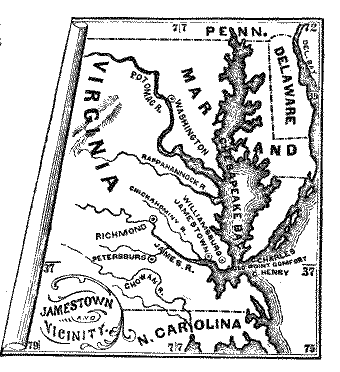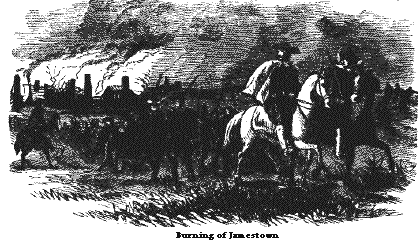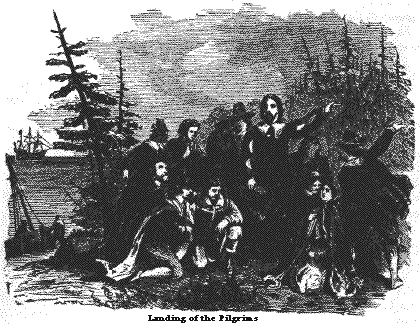Resource Center OLLibrary
|
|
33 |
at the price, at first, of one hundred and twenty, and
afterwards. one hundred and fifty pounds of tobacco, which was
worth, at the time, three shillings a pound. Accessions of a
different character were also made to the colony. By order of King
James, one hundred criminals were sent over, to be sold as
servants for a term of years.
 12.
Indian Massacre and War. -- The colony was now enjoying
great prosperity; but in
12.
Indian Massacre and War. -- The colony was now enjoying
great prosperity; but in ![]() 1622 it experienced a stroke which. nearly proved fatal.
Opechancanough, the chief of the Powhatans, proud,
revengeful, and extremely hostile to the English, concerted a plan
to cut them off at a blow; and it was so far put in execution that
three hundred and forty-seven persons -- men, women, and children
-- were slain almost in the same instant.
1622 it experienced a stroke which. nearly proved fatal.
Opechancanough, the chief of the Powhatans, proud,
revengeful, and extremely hostile to the English, concerted a plan
to cut them off at a blow; and it was so far put in execution that
three hundred and forty-seven persons -- men, women, and children
-- were slain almost in the same instant.
13. The whole surrounding Indian
population had been enlisted by the artful Opechancanough,
Powhatah's successor. Jamestown and some of the neighboring places
were saved by the disclosure of a friendly Indian and
messengers were sent out to warn the people, but it was too late
to reach the distant settlements. As soon as the English
had time to recover themselves, they rose to avenge the death of
their slaughtered friends, destroyed many of the savages, and
drove the remainder far into the wilderness. -- But, by the
calamities which fell upon the colonists, their settlements were
reduced from eighty to less than eight; in a short time, out of
four thousand persons, but twenty-five hundred remained.
Expeditions for exterminating the savages were occasionally made
for ten years.
II. VIRGINIA A
ROYAL PROVINCE. --
1. The stockholders of the London Company had become very
numerous, and the king, unable to restrain the freedom with which
they discussed the royal prerogatives, took away their
charter, in 1624.
QUESTIONS. -- What was the price of a wife? What other accessions were made to the colony? 12. What plan did Opechancanough concert? When? How far was his plan put in execution? 13. How were Jamestown and other places saved? How did the English avenge the death of their friends? To what extent were their settlements and population reduced? 1. When and why was the London Company deprived of its charter?
|
34 |
|
T![]() he
government of the colony was assumed by the crown, and vested in a
governor and twelve councillors appointed by the king. Virginia
was, however, permitted to retain its legislative assembly.
he
government of the colony was assumed by the crown, and vested in a
governor and twelve councillors appointed by the king. Virginia
was, however, permitted to retain its legislative assembly.
2. Second Indian War. -- In 1644 the
Indians, who had remained unfriendly since the war of 1622, made a
second attack on the English. By this onslaught about three
hundred persons, in the frontier settlements, lost their
![]() lives. A
vigorous war was immediately begun against the savages. The aged
Opechancanough was taken prisoner, and shot by a soldier. The war
continued about two years, and ended in the cession of large
tracts of land to the English.
lives. A
vigorous war was immediately begun against the savages. The aged
Opechancanough was taken prisoner, and shot by a soldier. The war
continued about two years, and ended in the cession of large
tracts of land to the English.
3. The sympathies of the colonists
were with the king during the civil war in the mother country; and
after the execution of King Charles I., his son, a fugitive from
England, was recognized by the Virginians as their rightful
![]() sovereign.
On the restoration of Charles II. to the throne, in 1660,
he confirmed Sir William Berkeley in the office of governor, which
he already held by the will of the people. From this time the
governor seems to have devoted himself to restricting the
liberties of the colonists; and they sent agents to England to lay
their grievances at the foot of the throne. But Charles chose to
forget Virginia's loyalty to him in exile, and the people could
obtain no redress.
sovereign.
On the restoration of Charles II. to the throne, in 1660,
he confirmed Sir William Berkeley in the office of governor, which
he already held by the will of the people. From this time the
governor seems to have devoted himself to restricting the
liberties of the colonists; and they sent agents to England to lay
their grievances at the foot of the throne. But Charles chose to
forget Virginia's loyalty to him in exile, and the people could
obtain no redress.
4. Navigation Acts. -- During the
time of the Commonwealth, Parliament had extended its authority to
![]() America,
in an act requiring all exports from the colonies to England to be
carried in English or colonial vessels (1651).1
Virginia had reason to expect, after the restoration, some special
marks of the king's favor. In 1660, however, an additional act
required her, in common with the other colonies, to find in
England alone a market for her principal exports; and, soon after,
another act required the colonies to bring from England
America,
in an act requiring all exports from the colonies to England to be
carried in English or colonial vessels (1651).1
Virginia had reason to expect, after the restoration, some special
marks of the king's favor. In 1660, however, an additional act
required her, in common with the other colonies, to find in
England alone a market for her principal exports; and, soon after,
another act required the colonies to bring from England ![]() alone
their principal imports. In 1672 duties were imposed upon articles
imported from one colony to another. These restrictions upon
commerce began that series of aggressions which a century later
drove the colonies into the war of the
revolution.2
alone
their principal imports. In 1672 duties were imposed upon articles
imported from one colony to another. These restrictions upon
commerce began that series of aggressions which a century later
drove the colonies into the war of the
revolution.2
5. Bacon's Rebellion. -- Many of the
Virginia planters, indignant at the tyranny of Governor Berkeley,
and disgusted with his inefficient measures for defence against
the Indians, rose in opposition to his government in
1676,3
1 This act was intended both to promote English navigation and to strike a blow at the naval power of the Dutch, who were then engrossing almost the whole carrying trade of the world.
2 See pp. 101. 111. 3 One hundred years before the declaration of independence.
QUESTIONS. -- What is said of the government of the colony? 2. Give an account of the second Indian war. 3. With which party did the colonists sympathize during the civil war in England? What is said of Berkeley? 4. What navigation acts are mentioned? What is said of these restrictions upon commerce? 5. Give an account of Bacon's rebellion.
|
|
35 |
under the lead of Nathaniel Bacon, one of the
council. The insurgents were making rapid headway against the
governor, when Bacon suddenly died, and with him the cause he had
espoused.
6. The immediate cause of this
outbreak was the depredations of some Indians from Maryland, who,
in revenge for the treacherous murder of several of their chiefs,
committed many barbarities on the planters.1 As
Berkeley would not defend them, the people demanded of him
permission to arm and defend themselves. They also asked as a
leader Nathaniel Bacon, a young man of great popularity, and
distinguished for his talents and energy. The governor, fearing to
put arms into the hands of discontented men, and jealous of
Bacon's influence, refused. The Indians continued their ravages,
attacking Bacon's plantation, and killing a number of his men.
Without a commission, he placed himself at the head of those who
had volunteered to repel the savages. Soon, duplicity on the part
of the governor and his adherents compelled Bacon, in
self-defence, to attack them in Jamestown. Berkeley's supporters
made but a feeble resistance, and then fled from the town, which
was burned to prevent their return.

On the death of Bacon, Berkeley recovered his power, and
wreaked his vengeance on the patriots with fines, confiscations,
and executions, till the thoughtless and ungrateful Charles
declared, "The old fool has taken away more lives in that naked
country, than I for the murder of my father."
7. The
Virginians, though oppressed for some years by needy and
covetous governors, continued eminently loyal, and when the
Revolution in England placed William and Mary on the throne, in
1689, acknowledged with reluctance the new
sovereigns. See p. 78. ¶ 14.
1 This was the year of King Philip's war in New England, 1676. See p. 42, ¶ 4, and p. 61, ¶ 8.
QUESTIONS. -- Who was its leader? Its result? 6. Give the particulars of this rebellion. 7. What is said of the Virginians?
|
36 |
|
CHAPTER II.
MASSACHUSETTS.1
I.
NORTH VIRGINIA. --
1. Soon after the issue of the Virginia
Charter,2 the Plymouth Company sent out a number of
emigrants under George Popham, to establish a plantation in
North Virginia. *1607.* The same year that Jamestown was settled
they landed near the mouth of the Kennebec, and erected a fort,
which they named Fort St. George. But discouraged by the rigors of
a severe winter, and by the death of their leader, they returned
the next year to England.
2.
In 1614, Captain John Smith3 sailed from
England with two ships, for purposes of trade ![]() and
discovery in North Virginia. Leaving a part of his company at
Monhegan Island,4 to engage in fishing, he explored the
coast from the Penobscot to Cape Cod, made a map of it, and named
the country New England, which name was confirmed by Prince
Charles (afterwards Charles 1.).
and
discovery in North Virginia. Leaving a part of his company at
Monhegan Island,4 to engage in fishing, he explored the
coast from the Penobscot to Cape Cod, made a map of it, and named
the country New England, which name was confirmed by Prince
Charles (afterwards Charles 1.).
3.
In 1620 the old Plymouth Company was dissolved, and another
charter was obtained from the king, by which a new company was
formed, called the Council of Plymouth. To this company was
granted, under the name of New England, in absolute
property, all the territory between the fortieth and forty-eighth
degrees of north latitude (that is, from about the latitude of
Philadelphia to the latitude of the Bay of Chaleurs), and
extending from the Atlantic to the Pacific.
This charter was the basis of the several
grants subsequently made of the New England territory, which,
however, was destined to be first settled without any patent from
the Council of Plymouth, or from the king, and, indeed, without
their knowledge.
II. PLYMOUTH
COLONY. -- 1. In 1620 a colony of
Puritans from England reached the coast of ![]() Massachusetts,
and landing December 21,5 began a settlement which was
named Plymouth.6 This was the first permanent
settlement in what is now called New England.
Massachusetts,
and landing December 21,5 began a settlement which was
named Plymouth.6 This was the first permanent
settlement in what is now called New England.
The Puritans were dissenters from
the Church of England, and because they desired a purer
form of worship, received from their enemies, in derision, the
name which they have made honorable. A band of
these,
1 See Map, p. 45. and p. 39, note 1. 2 See p. 17, § III. 3 See pp. 30,31.
4 This Island, on the coast of Maine, had for some years been the rendezvous of fishermen, and for a long time remained, as it has again become, the centre of important fisheries.
5 December 11, O. S. 6 The spot was named Plymouth on Smith's map.
QUESTIONS. -- 1. Give an account of the expedition under George Popham. 2. Give an account of the expedition under Captain John Smith. 3. When was the Plymouth Company dissolved, and what company took its place? Give the name and limits of the grant to the new company. -- Of what was its charter the basis? II. 1. When, where, and by whom was the first permanent settlement in New England made? Who were the Puritans? Why so named?
|
|
37 |
with their able and pious pastor, John Robinson, in 1608 took
refuge in Holland from the persecutions they suffered in
England.
2. After some
years they determined to remove to America.1 To carry
but this design, they formed a partnership with certain
merchants of London. The merchants were to furnish money and share
the profits with the colonists, who were to furnish labor
.2 Having kept a day of solemn humiliation and prayer,
the Pilgrims embarked for Southampton, where they were joined by
others from London. In August, 1620, they set sail for the New
World in two vessels, the Speedwell and the Mayflower. But the
Speedwell soon sprung a leak, and they put back to Plymouth, where
she was condemned as unseaworthy; and the Mayflower, taking on
board one hundred and two of the emigrants, sailed from Plymouth
in the month of September. They intended to settle near the Hudson
River, but after a tempestuous passage of more than two months,
they came to anchor in the harbor of Cape Cod.

3. Before landing the male immigrants subscribed their names to a written agreement to obey such laws as might be enacted from time to time for the common good.
1 They were induced to take this step from the fear lest their posterity should mingle with the people of Holland, and their church became extinct, and from the hope of laying a foundation for the extensive advancement of the kingdom of Christ in America.
2 At the end of seven years all the property held by the company was to be divided among the merchants and colonists, so that the former should draw as large a share of the profits for each contribution of £10 (about $50) as the latter for seven years of labor.
QUESTIONS. -- Where did some of them take refuge? What partnership did they form? Describe their voyage in the Mayflower. 3. What took place before landing?
|
|
|
|
|
|
© 1999, 2000, 2001 for NEGenWeb Project by Ted & Carole Miller